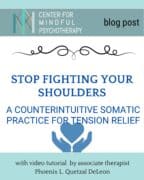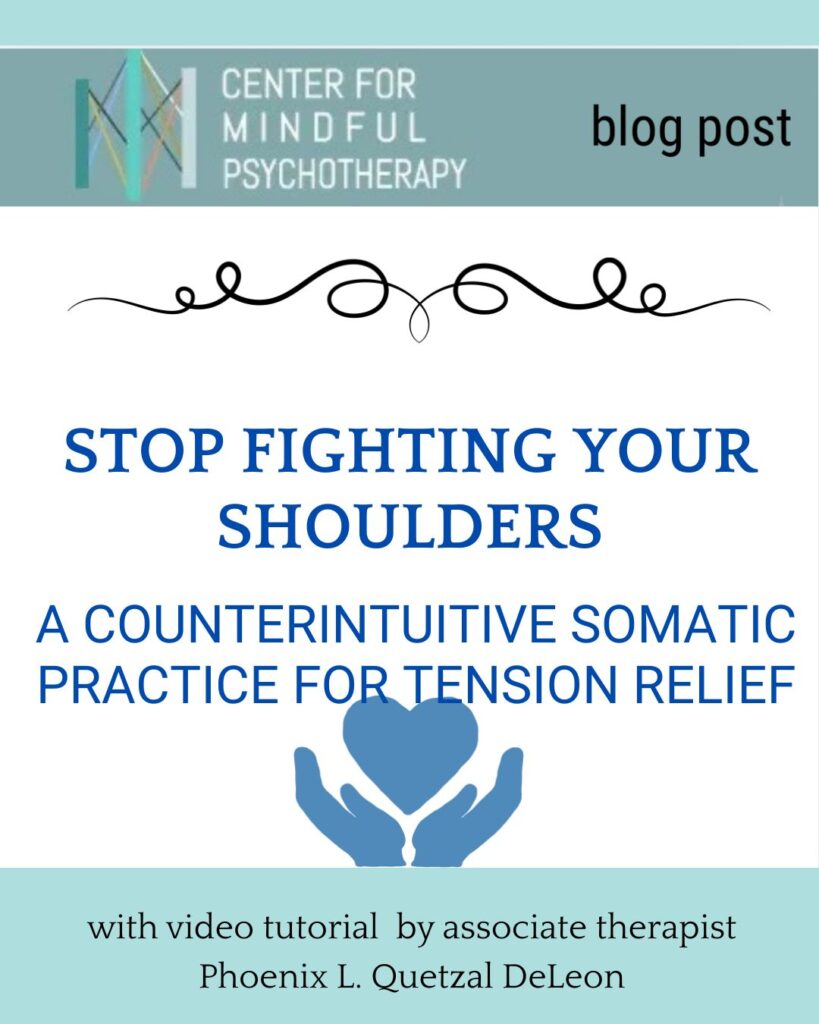
In this post, we share a video from associate therapist Phoenix L. Quetzal DeLeon demonstrating a simple yet powerful somatic practice for shoulder tension relief, and explore why our typical approach to relaxation often backfires. Plus we share some of the neuroscience behind why working with contrast, rather than against your body, creates lasting change.
Why Trying to Force Relaxation Often Makes Tension Worse And What to Do Instead
You’re sitting at your computer, and suddenly you notice it: your shoulders have crept up toward your ears again. You consciously push them down, telling yourself to relax. Five minutes later, they’re back up. You push them down again. And so the cycle continues throughout your day.
If this sounds familiar, you’re not alone … and more importantly, you’re not doing anything wrong. The problem isn’t your shoulders. The problem is that we’ve been taught to approach tension relief in a way that often works against our body’s natural wisdom.
Phoenix L. Quetzal DeLeon, MA, AMFT, a somatic therapist here at the Center for Mindful Psychotherapy, has created a brief video demonstrating a surprisingly effective approach to shoulder tension that goes against our instincts. Instead of forcing our shoulders to relax, Phoenix teaches a practice rooted in working with contrast which is a fundamental principle in somatic therapy that can transform how we relate to tension in our bodies.
The Hidden Problem with “Just Relax”
Before we dive into the practice itself, it’s worth understanding why the typical approach to shoulder tension often backfires.
When we notice tension and immediately try to force relaxation, we’re inadvertently creating what Phoenix describes as “a conflict with our shoulders.” We’re essentially telling our body that what it’s doing is wrong, creating a mental battle: “My shoulders should be relaxed. Why won’t they relax? What’s wrong with me?”
This internal conflict adds another layer of stress on top of the physical tension we’re already experiencing. We end up in a paradoxical loop: trying to relax makes us more tense because we’re working so hard at it.
From a nervous system perspective, forcing relaxation engages our conscious, effortful control which itself activates the sympathetic nervous system (our stress response). We’re trying to create relaxation through a pathway that actually generates more activation. No wonder it doesn’t work.
Why Modern Life Creates Chronic Shoulder Tension
Our shoulders carry more than we realize both literally and metaphorically. The phrase “shouldering a burden” isn’t just a metaphor; our bodies actually express stress, responsibility, and overwhelm through shoulder tension.
Common physical contributors include:
- Hours spent looking at screens with our heads tilted forward
- Driving with arms extended and shoulders rounded
- Poor ergonomic setups at work or home
- Carrying bags, children, or other heavy loads
Emotional and psychological factors:
- Chronic stress and anxiety (the body’s protective “bracing” response)
- Feeling overwhelmed or “carrying the weight of the world”
- Unconscious protective posturing from past trauma
- Hypervigilance and difficulty feeling safe
The body doesn’t distinguish between physical and emotional stress—it responds to both with similar patterns of tension. This is why simply addressing the physical component often isn’t enough for lasting relief.
A 2022 research study found in the National Library of Medicine shares: “Psychological stress including job stress can increase muscle tension and activity, which can increase shoulder pain. Also, psychological factors such as depression and anxiety may influence shoulder pain intensity, and inversely, shoulder pain may affect psychological factors. Since people with high levels of pain perceive their pain as a threat, high levels of shoulder pain can increase depressive symptoms, stress, and anxiety.”
The Power of Working with Contrast: A Somatic Principle
Phoenix’s video demonstrates a practice based on an important somatic principle: the body learns through experiencing contrast.
Rather than trying to go directly from tension to relaxation (which our nervous system often resists), we can create a bridge by first intentionally amplifying the tension. This approach works for several reasons:
1. It ends the internal conflict. Instead of fighting against the tension, we’re temporarily moving toward it. This shifts us out of the struggle.
2. It increases body awareness. By consciously exaggerating the tension, we develop a much clearer sense of what tension actually feels like in our body—which is essential for learning to release it.
3. It creates a clearer reference point for relaxation. After holding intense tension, our nervous system can much more easily recognize and move into the contrasting state of release. The difference becomes obvious rather than subtle.
4. It engages the rebound effect. When we intentionally create and then release muscle tension, the muscles often relax more fully than they were before we started—a principle used in Progressive Muscle Relaxation techniques that have decades of research support.
Watch: A Simple Practice for Shoulder Tension Relief
In this video, Phoenix walks you through this gentle, embodied practice. The entire exercise takes less than three minutes and can be done anywhere … at your desk, in your car, or whenever you notice shoulder tension creeping in.
WATCH THE VIDEO HERE:
PhoenixDeLeonLandscapeVideoFall2025
Breaking Down the Practice: Step-by-Step
While the video provides a guided experience, here’s a written breakdown of the technique:
Step 1: Notice the tension Begin by simply observing that you’re experiencing shoulder tension. Your shoulders might be slightly lifted, or you might just have a sense of tightness in the area.
Step 2: Exaggerate the tension Instead of trying to release it, intentionally bring your shoulders up higher. Then higher still. Keep lifting them toward your ears, amplifying the sensation of tension. Really feel it.
Step 3: Hold and observe Maintain this exaggerated tension for several seconds (but don’t hurt yourself—work within a comfortable range). Notice what this feels like. Where do you feel it? How intense is it?
Step 4: Let it drop Suddenly, all at once, let your shoulders drop completely. Release all effort. Let gravity take over.
Step 5: Notice the relief Pay attention to the sensation of release. What does ease feel like in your shoulders? How is this different from the tension you were holding?
Step 6: Repeat as needed If you still notice tension, you can repeat the cycle. Often, just one or two rounds creates significant relief.
Why This Practice Works: The Neuroscience of Contrast
From a neuroscience perspective, this practice is brilliantly designed. Here’s what’s happening in your nervous system:
- Proprioceptive clarity: By exaggerating the movement, you’re sending much stronger signals to your brain about what your shoulders are doing. This enhanced proprioceptive feedback makes it easier for your nervous system to coordinate the opposite movement (release).
- Voluntary control followed by surrender: You’re using conscious control to create the tension, then practicing the essential skill of letting go. This builds the neural pathway for releasing tension on demand.
- Pendulation: This is a somatic principle where we gently move between states (tension and ease, contraction and expansion) to build nervous system flexibility. The more we can move between these states, the less likely we are to get stuck in chronic patterns.
- Completing the stress cycle: Often, tension gets stuck because stress responses were interrupted or incomplete. By fully expressing the tension pattern and then consciously releasing it, we’re allowing the body to complete a cycle that may have been held for hours, days, or even longer.
Expanding the Practice: Other Applications
While Phoenix demonstrates this practice with shoulders specifically, the principle of working with contrast can be applied throughout the body:
- Jaw tension: Exaggerate clenching before releasing
- Fist clenching: Make tight fists, then fully open and release your hands
- Facial tension: Scrunch your face tightly, then release into softness
- Full body: Create tension throughout your entire body, then let it all go at once
The key is to work with your body’s existing patterns rather than against them, using intentional exaggeration as a bridge to release.
When to Practice: Building Body Awareness into Your Day
One of the benefits of this practice is its simplicity and accessibility. You don’t need special equipment, a quiet room, or even much time. Here are some opportune moments to use this technique:
- During work breaks: Set a timer to check in with your shoulders every hour
- Before meetings or stressful events: Release tension before it accumulates
- While commuting: At red lights or during transit
- During your morning routine: Start the day with awareness of your body
- Before bed: Release the day’s accumulated tension
- Anytime you notice discomfort: Use body signals as cues to practice
The more you practice, the more quickly you’ll be able to recognize tension patterns as they’re forming—rather than hours later when they’ve become entrenched.
Beyond the Quick Fix: Somatic Therapy for Deeper Patterns
While this simple practice can provide immediate relief, Phoenix emphasizes that it’s just one example of how somatic therapy might support you. If you’re dealing with chronic tension, anxiety, or stress patterns that persist despite your best efforts, working with a skilled somatic therapist can help you:
- Understand the root causes of your tension patterns—not just the physical mechanics, but the emotional and psychological factors that contribute to them.
- Develop a broader toolkit of somatic practices tailored to your specific needs and challenges.
- Address trauma held in the body that may be expressing itself through chronic tension, pain, or other somatic symptoms.
- Build lasting body awareness that allows you to recognize and respond to stress signals before they become overwhelming.
- Work with the whole person—acknowledging that body, mind, emotions, and life experiences are all interconnected.
Phoenix brings over 25 years of experience as a teacher and bodywork practitioner (including certifications as an Advanced Rolfer and Rolf Movement Practitioner) into their work as a somatic therapist. This extensive background in understanding how bodies move, hold tension, and release provides a unique depth to their therapeutic approach.
The Bigger Picture: Befriending Your Body
At its heart, this shoulder tension practice represents a fundamental shift in how we relate to our bodies. Instead of viewing tension as an enemy to be conquered or a problem to be fixed, we’re learning to:
- Listen to our body’s messages rather than overriding them
- Work with our natural patterns rather than against them
- Cultivate curiosity about our embodied experiences
- Practice self-compassion for what our bodies are carrying
This shift from conflict to collaboration with our bodies is at the core of somatic therapy—and it’s what makes these practices so transformative over time.
Your body isn’t broken when it holds tension. It’s actually doing its job: responding to stress, protecting you, holding the weight of your experiences. The question isn’t how to stop your body from responding this way, but rather how to support it in finding more ease and flexibility within those responses.
Try It Now: An Invitation
Before you finish reading this post, why not try the practice right now? Notice where your shoulders are at this moment. Are they lifted? Tight?
Take a moment to watch Phoenix’s video again, and this time, practice along. Notice what you experience. What does the tension feel like when you exaggerate it? What does the release feel like afterward? How do your shoulders feel different now compared to when you started reading?
This kind of embodied learning—experiencing the practice in real-time rather than just reading about it—is the essence of somatic work.
Getting Started with Somatic Therapy
If you’re curious about exploring somatic therapy more deeply, Phoenix offers individual therapy sessions for adults and teens in California. They specialize in working with:
- Anxiety and stress management
- Recovery from trauma and PTSD
- Body image issues and eating disorder recovery
- Relationship challenges
- Identity development (including work with LGBTQI+, gender expansive, and BIPOC clients)
Phoenix’s approach is grounded in social justice, liberation psychology, Health at Every Size®, and a wide variety of somatic practices. They value creating sacred space where you can safely explore your inner landscape—including the wisdom your body has to offer.
To learn more about Phoenix’s work or to schedule a consultation, visit therapywithphoenix.com or contact them at [email protected] or (408) 706-2770.
Your body is trying to communicate with you through tension. Learning to listen and respond with compassion rather than force can change everything.
Phoenix L. Quetzal DeLeon, MA, AMFT #129332, is a somatic therapist at the Center for Mindful Psychotherapy in Santa Clara, California. With over 25 years of experience in teaching and bodywork, including certifications as an Advanced Rolfer and Rolf Movement Practitioner, Phoenix brings a deeply embodied understanding to their therapeutic work. They specialize in supporting individuals working through anxiety, trauma, and body image concerns using trauma-informed, relational, and somatic approaches.
Additional Resources
Related posts you might find helpful:
- Understanding the Messages of the Body: How Somatic Therapy Can Help
- From Mind vs. Body to Mind and Body
- 3 Key Benefits of Somatic Trauma Therapy for PTSD Recovery
To explore other services at Center for Mindful Psychotherapy: Visit our therapist directory.






